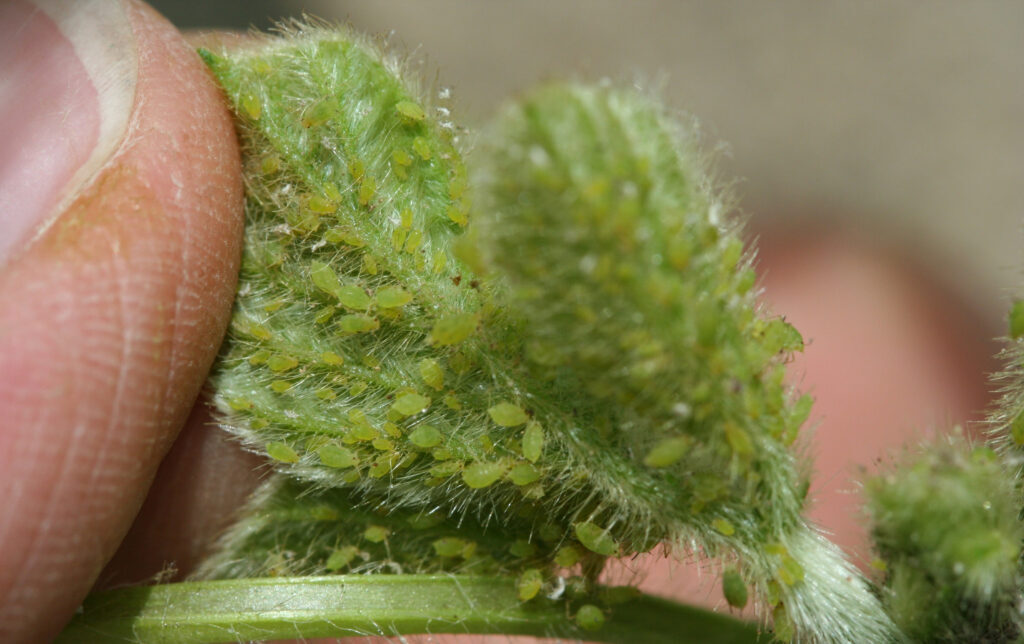Soybean Aphid Scouting and The Role of Digital Scouting Tools
Soybean aphids (Aphis glycines) are small, pear-shaped insects that feed on the sap of soybean plants. They are native to Asia but have spread to many other regions, including North America, where they can cause significant damage to soybean crops. Soybean aphid scouting helps in Identifying and managing soybean aphids on time. It is an important aspect of integrated pest management (IPM) for soybean production.
What are soybean aphids?
Soybean aphids are small insects that range in color from pale green to yellow or brown. They have long antennae and two short tubes, or cornicles, on the rear of their bodies. Soybean aphids reproduce asexually, with female aphids giving birth to live offspring. They can produce several generations per season, with the number of generations varying depending on the region and climate. Soybean aphids feed on the sap of soybean plants, resulting in reduced plant growth, stunted plants, and reduced yields. In severe infestations, soybean aphids can also vector viral diseases.
It is important to monitor for soybean aphids and implement management strategies to reduce their populations and prevent the spread of viral diseases. This can include the use of insecticides, as well as cultural practices such as crop rotation and planting resistant varieties.

When to scout for soybean aphids
It is important to start scouting for soybean aphids at the early vegetative stage of development. Soybean aphids are most likely found on soybean plants’ lower leaves and stem and are most active during warm, humid weather. Therefore, regularly scout for soybean aphids throughout the growing season, especially during the vegetative and reproductive stages of soybean development.
During the early vegetative stage, you should focus on identifying the presence of soybean aphids and monitoring their population levels. This will allow you to determine whether treatment is necessary and, if so when the treatment should be applied. If you wait until later in the growing season to start scouting, you may miss the opportunity to control soybean aphid populations and prevent yield losses effectively.
In addition to regular scouting, it is also helpful to use a growing degree days (GDD) model to predict the timing of key developmental stages for soybean aphids, such as egg hatch, nymphal development, and adult emergence. This can help you plan your scouting activities and ensure that you are monitoring for soybean aphids at the most critical times.
In addition, fields that have a history of soybean aphid infestations or are near infested fields should be monitored more closely.
How to scout for soybean aphids
There are several steps involved in conducting a thorough soybean aphid scout:
Select representative plants: Choose plants representing the field, including plants of different ages and at various locations within the field.
Count aphids: Examine the lower leaves and stems of the selected plants for soybean aphids. Count the number of aphids on each plant and record the data.
Evaluate the level of infestation: Determine the soybean aphid infestation based on the number of aphids found per plant. A low infestation level is typically considered fewer than 250 aphids per plant, while a moderate infestation level is 250-999 per plant. An infestation level of 1,000 or more aphids per plant is considered severe. Start applying treatment when more than 250 aphids were counted per plant.
Management options
Several options for managing soybean aphids include chemical, biological, and cultural approaches. Chemical control methods, including the use of insecticides, can be an effective way to manage soybean aphid (Aphis glycines) infestations. Systematic insecticides are a type of chemical control method that can be used to manage soybean aphid infestations. Systematic insecticides are applied to the soil, taken up by the plant, and distributed throughout the plant tissue. This allows the insecticide to provide long-lasting control of soybean aphids and other insects that feed on the plant. These insecticides can be used as a seed treatment or soil drench. Seed treatments are applied to the seed before planting and protect emerging seedlings.
Systematic insecticides reduce the need for multiple applications throughout the growing season. However, they also have some limitations. Systematic insecticides may be less effective at controlling high soybean aphid populations. Due to their persistence in the environment, they may significantly impact non-target organisms, such as pollinators. It is important to choose an insecticide that is specifically labeled for use on soybeans, and that is effective against soybean aphids.
It is also important to consider the potential for insecticide resistance, which can repeatedly occur when soybean aphids are exposed to the same insecticide. To reduce the risk of resistance, it is important to rotate between different classes of insecticides and to use multiple control methods in combination.
Biological control methods involve natural predators, such as ladybugs and lacewings, to reduce soybean aphid populations. Cultural control methods include crop rotation, planting resistant varieties, and avoiding late planting, which can reduce the risk of soybean aphid infestations.
Digital field scouting app
Digital scouting apps, such as Agrio, can be a helpful tool for keeping track of pest infestations, including soybean aphids (Aphis glycines). These apps can help simplify the scouting process by providing a platform for recording and organizing data about pest populations, crop development, and management strategies.
Agrio can help with pest counting by using computer vision technology to analyze images of pest infestations. This can be especially useful for quickly and accurately counting large numbers of pests, such as soybean aphids, which can be time-consuming and challenging to do manually.
To use this feature, you would need to take photographs of the pests using your smartphone or other device and upload them to the app. The app would then use artificial intelligence algorithms to identify and count the pests in the images.
Summary
Soybean aphid scouting is important in managing soybean crops and preventing yield losses. Digital tools help field scout professionals to complete their tasks quickly and accurately and share their findings with their teams and clients.
